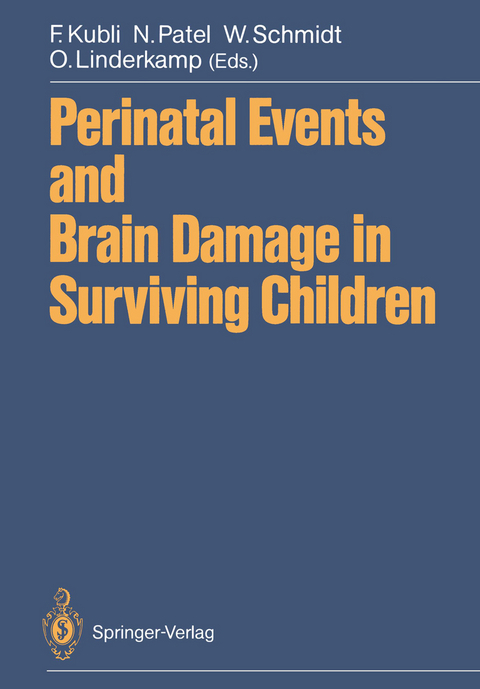
Perinatal Events and Brain Damage in Surviving Children
Springer Berlin (Verlag)
978-3-642-72852-5 (ISBN)
Epidemiology.- Definitions, Risks and Indices.- The Quantification of Risk Factors in Major Neurodevelopmental Disorders.- Epidemiologic Panorama of Brain Impairments and Causative Factors - Swedish Experiences.- Low Birthweight and Neurological Sequelae - A Summary of Some Swedish Studies.- Biology and Pathogenetic Mechanisms.- Genetic Factors Leading to Birth Defects and Diseases of the Newborn.- Developmental Neurology of the Fetus and Newborn.- Pathophysiological Mechanisms Leading to Permanent Brain Damage in Surviving Children.- Trauma and the Developing Brain.- How and When Does Antenatal Hypoxia Damage Fetal Brains?.- Intrauterine Deprivation - Growth Retardation and Chronic Hypoxia.- Antepartum Events and Cerebral Handicap.- Available Evidence Relating Intrauterine Growth Retardation to Neuromotor Dysfunction and Mental Handicap.- Growth Retardation: Individual Risk Assessment During Pregnancy.- Management of Growth Retardation with a View to Preventing Neuromotor Dysfunction and Mental Handicaps ..- Abnormal Antepartum Cardiotocogram and Neuromotor Dysfunction in Term and Preterm Babies.- Antepartum Fetal Heart Rate and Movement Pattern in Relation to Oxygenation and Neonatal Neurological Morbidity.- Intrapartum Asphyxia and Birth Trauma.- Intrapartum Events and Cerebral Palsy.- The Relationship Between Obstetrically Preventable Intrapartum Asphyxia, Abnormal Neonatal Neurological Signs and Subsequent Motor Impairment in Babies Born at or After Term.- Available Evidence Relating Abnormal Intrapartum Fetal Acid Base Balance (pH) to Neuromotor Dysfunction and Mental Handicap.- Intrapartum Cardiotocogram, Apgar Score and Acidaemia at Birth: Relationship to Neonatal Neurological Morbidity.- Neurological Morbidity of Term Infants as an Indicator of SafeObstetrical Practice.- Breech Delivery in the Term Fetus - Relation to Neuromotor Dysfunction and Mental Handicap.- Intracranial Hemorrhage and Ischemia.- Pathological Anatomy of Intraventricular Hemorrhage in the Preterai Baby.- Hypoxia, Loss of Autoregulation and Intracranial Hemorrhage.- Obstetrical Factors and Intracranial Hemorrhage.- Prevention of Intraventricular Hemorrhage: Role of Atraumatic Birth and Sedation.- Prediction of Outcome: Periventricular Hemorrhage Versus Ischemia.- Magnetic Resonance Spectroscopy of the Brain and Early Neurodevelopmental Outcome.- Prognosis of the Very Low Birthweight and Very Preterm Infant.- Outcome of Very Low Birthweight or Very Preterm Infants with Special Consideration of Perinatal Events.- Role of Transport for the Prognosis of the Very Low Birthweight Preterm Infant.- Improved Outcome of Very Low Birthweight Infants 1977-1986. Critical Analysis of Results and Possible Mechanisms.- Decreasing Incidence of Neurological Morbidity and Changes of Perinatal Care Strategies in Very Low Birthweight Infants.- Prevention of Preterm Labor - A Means of Preventing Handicaps?.- Recent Follow-up Studies.- Causes of Handicap and Impairment in a Total Population of Dundee (Scotland) Children Aged 8 Weeks to 7 Years.- The Uruguayan Follow-up Study of Perinatal Events and Mental Handicaps.- First Results of the Multicenter Finnish-Bavarian Study.- Neurological Sequelae of Infants with Very Low Birthweight in Hamburg - First Results of a Regional Study.- Perinatal Mortality Statistics of the Avon County (UK) Population, 1976-1985, Using Figo 1982 Methodology.
| Erscheint lt. Verlag | 6.12.2011 |
|---|---|
| Zusatzinfo | XX, 338 p. |
| Verlagsort | Berlin |
| Sprache | englisch |
| Maße | 170 x 244 mm |
| Gewicht | 627 g |
| Themenwelt | Medizin / Pharmazie ► Gesundheitsfachberufe ► Hebamme / Entbindungspfleger |
| Medizin / Pharmazie ► Medizinische Fachgebiete ► Gynäkologie / Geburtshilfe | |
| Schlagworte | anatomy • Birth • Fetus • newborn • Pregnancy • Regulation |
| ISBN-10 | 3-642-72852-9 / 3642728529 |
| ISBN-13 | 978-3-642-72852-5 / 9783642728525 |
| Zustand | Neuware |
| Haben Sie eine Frage zum Produkt? |
aus dem Bereich


